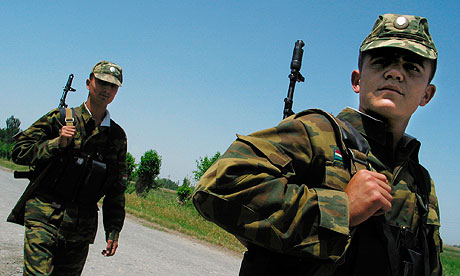
Tajikistan Suffers the Effects of Its Porous Afghan Border
Publication: Eurasia Daily Monitor Volume: 8 Issue: 116
By:

On May 31, a group of Afghan cattle raiders stole some 80 cows from a farm in Shurobod district, on Tajikistan’s southern border with Afghanistan. Under the cover of the night, the armed raiders drove the cows across the Panj River, which separates the two countries. Earlier in the year, Afghans kidnapped two residents of the district. One of them was recently released after his relatives paid the ransom money (www.regnum.ru, June 2; www.avesta.tj, June 7).
These incidents demonstrate that almost six years after Tajik border guards assumed full control of the Afghan border, the frontier remains severely ill-protected. Part of the problem is the border’s geography. Much of the 1,344 kilometers (840 miles) Tajik-Afghan frontier is mountainous terrain, which makes it easier for Afghan smugglers to hide from Tajik border patrols and escape quickly when they are spotted.
Another element of the problem is Tajikistan’s limited border control capacity. The country’s border forces do not have sufficient manpower and other resources to effectively police the Afghan frontier. According to General Sharaf Fayzulloyev, deputy commander of Tajikistan’s border troops, the country’s border defenses are outdated. Most of the border outposts along Tajikistan’s southern frontier were built before the 1960’s and are beyond rehabilitation. Soviet-era vehicles have also outlived their use. Fayzulloyev said every kilometer of barbed wire installed along the Afghan border would cost $1 million, suggesting that even this barrier would not stop cross-border crime (www.news.tj, March 15).
A recent report by the US State Department’s international narcotics and law enforcement bureau suggests that Tajikistan has not built or rehabilitated any border outposts in recent years. Moreover, some of the Soviet-era border control facilities have been abandoned recently because the government could not staff and supply them. Rampant corruption adds to Tajikistan’s border problems. Anecdotal evidence suggests that large bribes help Afghan smugglers to easily cross the Tajik border (www.state.gov/p/inl/rls/nrcrpt/2011/vol1/156363.htm#tajikistan, March 3).
The long and sparsely guarded border and Tajikistan’s expedient transport links to Russia make the Tajik-Afghan border a favorite route for narcotics traffickers. An estimated 20 percent to 30 percent of opium and heroin produced in Afghanistan is smuggled through Central Asia – mainly Tajikistan – en route to Russia, China and Eastern Europe. Although Tajik law enforcement agencies seize more narcotics than other Central Asian countries, these seizures remain very low compared to the total flow of narcotics passing through the country. Besides, narcotics interceptions in Tajikistan dropped from over 8 metric tons in 2004 to only 3.9 tons in 2010 (Drug Situation Review in Tajikistan, 2005; www.regnum.ru, January 27, 2011).
For Tajikistan, the security implications of the porous Afghan border are not limited to narcotics trafficking and its various effects, including growing drug abuse rates, crime and corruption. The unprotected border also makes Tajikistan vulnerable to infiltrations by militant, terrorist and extremist groups.
Since the withdrawal of Russian troops from the Afghan border in 2005, Dushanbe has been asking for international assistance in improving the technical and material capacity of the country’s border forces. The largest providers of such assistance were Russia, United States, the Organization for Security and Cooperation in Europe (OSCE), and UN Office for Drugs and Crime (UNODC).
Moscow’s support has almost exclusively focused on providing technical expertise and training to the fledgling Tajik border force. A group of Russian advisers is deployed in Dushanbe to enhance Tajikistan’s border control capacity, and hundreds of Tajik cadets have been educated in Russian military colleges. Moscow’s intentions have recently become a subject of intensive media speculation after senior Russian parliamentarians and foreign ministry officials suggested that Russia was prepared to return to the Tajik-Afghan border to help stem the flow of narcotics from Afghanistan. In May, Reuters news agency quoted unnamed high-ranking Tajik border officials as saying that Moscow was negotiating the deployment of as many as 3,000 troops on the Tajik-Afghan border (www.centralasianewswire.com, May 5). Tajik government officials have denied holding such talks with Russia.
While Washington’s assistance also includes a capacity building component, the US has mostly focused on providing more tangible support to the Tajik border forces. This support has included renovating major border posts and providing border patrols with modern communication equipment and all-terrain vehicles. According to the embassy in Dushanbe, the US has spent over $44 million on efforts to enhance the security of the Tajik-Afghan border since 1992 (www.dushanbe.usembassy.gov, September 17, 2010).
The OSCE has helped Tajikistan in developing a national border strategy and setting up a border management staff college where Tajik and Afghan border officials are now trained. UNODC has supported the renovation of border outposts and donated trucks and jeeps to Tajik border patrols. In March, the European Union’s special representative for Central Asia, Pierre Morel, said the EU planned to support Dushanbe in enhancing its border control, without describing what this support would entail (www.khovar.tj, March 15).
Tajikistan’s porous border with Afghanistan remains a major security challenge both for the country and other states in the region. To help stem the unrestrained flow of narcotics and militants through the Tajik-Afghan border, the US, EU and Russia should increase their support for Tajikistan’s border security. At the same time, Dushanbe must step up its own efforts to enhance border control and fight corruption among the country’s border officials.




